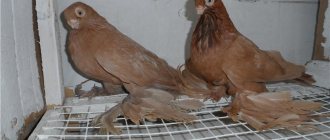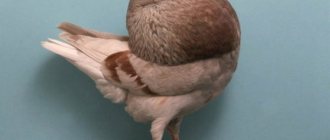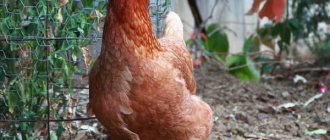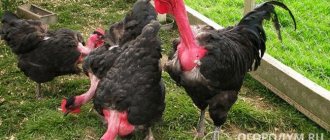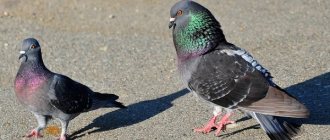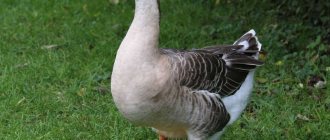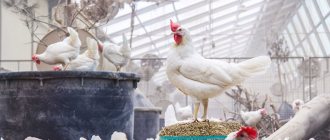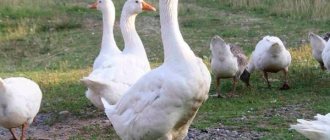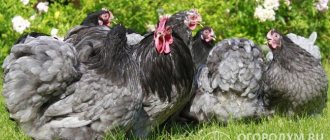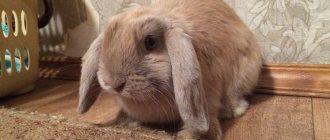Poultry farming » Pigeons
0
2080
Article rating
Kira Stoletova
Nikolaev pigeons are an ancient breed that was bred in the south of Ukraine, in the city of Nikolaev. It is not known exactly where their circleless ancestors came from. It is believed that pigeons appeared as a result of crossing breeds brought by sailors from Italy and the Middle East with local wild birds. Initially, pigeons were bred for meat, only over time they began to be valued due to their beautiful planning. According to the current classification, pigeons are classified as high-flying non-circling breeds.
Nikolaev pigeons
Origin story
What it looks like, photo:
The famous Nikolaev pigeons of Ukrainian origin appeared, as the name suggests, in the city of Nikolaev. This happened in the 19th century, and there is one version of their origin on the territory of Ukraine. Experts suggest that the sailors crossed foreign bird breeds with local species.
This happened taking into account the selection of pigeons, which have a circleless flight characteristic of this breed in our time. As for the formation of the breed in the form in which it has reached our time, it was, of course, largely influenced by the conditions of the local climate of the city of Nikolaev.
In this dry and warm area, where refreshing winds blow, with upward air currents, the formation of modern pigeons took place.
In Ukraine, not only ordinary people, but also many high-ranking officials are involved in breeding these beautiful birds. Currently, the breed has gained enormous popularity in Russia, where it is bred in many regions.
New video of Nikolaev pigeons
It is difficult to get acquainted with a breed of pigeons only by description. Studying the characteristics is not enough to fall in love with these proud and beautiful birds. A video will come to the rescue here, which will allow you to admire the Nikolaev pigeons, new products of the breed, and a gorgeous flight.
Flight of Nikolaev pigeons, video
Nikolaev pigeons are worthy representatives of their family. Duration of flight, attractive appearance, low maintenance requirements are only a small part of the advantages of the breed. Knowing what to pay attention to in raising Nikolaev birds, how to properly develop flight qualities and raise young animals, you can easily cope with the pigeon family. Even an increased risk of disease should not be an obstacle. Simple preventative measures are enough to raise a healthy flock of pigeons.
Read further:
Agaran pigeons - description and characteristics of an elite breed
Kursk pigeons are a rare and interesting breed
Dubovsky pigeons - description, flight qualities, breed standards
Peacock pigeons - description, maintenance, breeding
Description
This breed of pigeons has a special body structure, thanks to which they take off quickly:
- body length 40 cm;
- the body is long with a large chest;
- thick plumage all over the body, except for the legs;
- the wings are loosely attached to the body, long;
- strong wing muscles;
- The color of the plumage can be different: black, blue, yellow, gray, red, pockmarked, white with black spots on the head and neck, or with multi-colored splashes.
- for any color, the tail is white, wide, straight and consists of approximately 15 tail feathers;
- the head is narrow, round;
- eyes are small, yellow or orange;
- beak – medium in size, thin, tip curved down;
- the neck is short;
- when the bird is standing, the body is tilted 45 degrees relative to the ground;
- The male differs from the female in the size of the body (his is larger), as well as in the wide neck and lighter color of the feathers.
The behavior of birds is usually quite violent, especially among males. But despite this, they are good parents to their offspring. Chicks, in turn, from birth are similar to adults in character - just as active.
General impression
This is a large, strong pigeon, reaching a length of 40 centimeters, the only one in the world capable of flying vertically to great heights. Flight record holders don't always look pretty.
StandardFeaturesFlight and decorative qualities
The breed has a special body structure:
- The head is narrow and round. The eyes are small, yellow or orange, in white Nikolaevskys they are black-brown, in side-bodied ones they are golden or dark brown. The eyelid is narrow, light and pure beige.
- The beak is medium or slightly larger than average, thin and straight, tightly closed. At the end it bends down a little. It has a light or horny color. Small white waxets are tightly attached to the beak. The mandible is connected to the throat by a small arc.
- The neck is short and full, with rich plumage, gradually widening from the head to the shoulders. Males have thicker necks than females. The wings are long, dense, with wide flight feathers. The ends of the wings lie on the tail or are located on its sides, slightly not reaching its tip. The wide tail, long and straight, has 12-16 elastic, even tail feathers. Quickly expands to a semi-circle on takeoff.
- The body is wide at the shoulders, straight, elongated with well-developed muscles on the chest, forming one line with the tail.
- The legs are short, without feathers, red or brown in color. The claws of light pigeons are flesh-colored, while those of dark pigeons are gray.
Nikolaev pigeons are lively and energetic, they are famous for their high vitality, they easily get used to a new climate, and bear large offspring. Females hatch eggs well and successfully feed chicks. Pigeons are unpretentious in food and always return to the dovecote. They need systematic training and a strict diet. Young pigeons need to be taught to fly from the age of one and a half months.
Anyone can breed this breed, even a beginner pigeon breeder.
The positive features of Nikolaev pigeons include:
- uniqueness of the breed;
- ability to withstand long hours in the air;
- calm attitude towards people and animals;
- getting used to one owner;
- economical nutrition - 50 g of feed per day;
- caring for offspring;
- good vitality.
Minuses:
- strict requirements for temperature conditions in the dovecote;
- the wild character of the bird.
The Nikolaev pigeon breed requires hours of daily training in the sky. A bird that does not fly quickly gains excess weight and has difficulty returning to flight mode.
The pigeon has a good memory and is able to find its dovecote, even if it is blown over a long distance by a strong wind. It happens that pigeons disappear, but most return home.
Pigeon breeders gave two more names to the Nikolaev pigeon - “cloud cutter” and “butterfly”. Cloud cutters reach the clouds and rise higher. Butterflies are pigeons that can rise vertically without making a single circle. In this position, their tail is fluffed and their wings flutter at an angle of 45° to the vertical. The rise occurs due to the ability of pigeons to find warm rising air currents on the coast.
Flight qualities
Nikolaev high-flying pigeons are the only birds of their kind that take off and land vertically, rather than circling.
When flying, pigeons definitely need a headwind.
There are four flight styles in total:
- “butterfly” - continuous flapping of the wings, tilted slightly forward and the tail fully open;
- “lark” - straight, slightly fluttering wings are perpendicular to the body;
- end flight - vertical take-off, wings located at 90° to the body;
- sickle style - the wings are located in front of the body and bend into an arc, resembling a sickle.
The most common type of flight is “butterfly”, but untrained Nikolaev pigeons fly in the “lark” style.
Flight Features
All high-flying pigeons are distinguished by their flight technique:
- The round ones gradually rise upward and can circle in the sky for several hours.
- Persistent flyers soar upward without making a single circle and hover at high altitudes almost motionless.
Estimation of flight altitude
The main quality of the high-flying breed of pigeons is the duration of the flight and the maximum height to which the birds rise. To determine the approximate height estimate, a special scale has been developed:
- The height of the bell tower is 100-120 m.
- Lark - 150-350 m.
- Sparrow - 450-650 m.
- Butterfly - 640-840 m.
- Flickering height, when the size of the bird is determined by a point - 1250-1550 m.
Note! The maximum lifting height for high-flying pigeons is 1700 m.
Workout
To develop endurance and a certain flying style, pigeons need to be trained regularly.
Properly trained pigeons can fly for 6 to 10 hours without rest.
Before proceeding directly to training, you should make sure that young individuals:
- calmly fly high;
- can remain in the air for a long time;
- do not get lost at the sight of people and animals.
If all these qualities are absent, then such a pigeon can serve exclusively for decorative purposes.
Training begins at dawn, when it is fresh outside. They last no more than 6 hours a day with breaks.
The entire lengthy training process is divided into stages:
- Accustoming pigeons to the trainer. To do this, you need to come to the nursery every day in the same clothes. This way the birds will remember you and will eat from your hands, not be afraid of approaching, and sit on your shoulder.
- From 1.5-2 months, pigeons are released briefly from the nursery into an aviary.
- After 5-7 days they are released from the enclosure onto the roof of the dovecote. This stage lasts up to 5 days.
- The young can fly around the nursery together with the leader pigeon, which teaches them a certain style of flight.
- After 6-7 such trainings, you can let the pigeons fly alone or in a flock, but without a leader.
- After a short time, the birds will begin to spend 20-40 minutes in the air.
- When the flight time reaches 45 minutes, the youth can be released with an old pigeon that flies in the same style.
There are several prohibitions on training pigeons:
- training is temporarily stopped when the pigeon begins to molt and the fifth flight feather falls out - this process has a bad effect on the ability to fly;
- females cannot be trained before oviposition;
- Birds with different flight styles should not be released at the same time.
Sometimes birds fall during training. There are several most common reasons for this:
- inappropriate time for training (too hot, foggy);
- calm weather;
- various diseases;
- the birds lost their orientation.
Most common breeds
Reference books on pigeon breeding describe many different breeds of domestic pigeons, over 800. Most of them are bred in Europe and Central Asia. Approximately a quarter of all breeds were bred in the countries of the former USSR.
The most famous breeds are:
Grivuns. Bred in Russia, these pigeons are today distributed in all corners of the country. With a relatively medium size (36 centimeters), it can make flights up to 8 hours long. It has very dense plumage and is white with a spot on the neck.
Zaporozhye forelock pigeons. Bred by Zaporozhye pigeon breeders, this breed was practically destroyed after World War II, but was restored again in the early 80s. All representatives of the line have a peculiar forelock on their heads and bluish-colored plumage.
Aachen gulls. Bred in the 18th century near Aachen by crossing German lines with English gulls, this breed is very popular among connoisseurs. Looking at the photo of these domestic pigeons, you can’t help but be touched, they are so cute
.
Astrakhan pigeons. The breed was bred by Astrakhan pigeon breeders and became widely known; there are dovecotes with these birds in almost every city in central Russia. Individuals reach a length of up to 38 centimeters and have a rather large build.
Baku slaughterhouses. Originally from the city of Baku in Azerbaijan. They can spend up to 12 hours in the air at high altitude, which makes them the undisputed record holders in terms of flight. Individuals have an unsightly white-gray color, compensating for this with excellent performance in battle.
Content
Pigeons tolerate cold weather well, so even in winter they are kept in a spacious dovecote: 1 sq. m for a couple.
Basic conditions of detention:
- the optimal temperature in winter is +5 ℃, and in summer +20-25 ℃;
- additional lighting in the dovecote should extend daylight hours to 12 hours a day;
- Before the first mating (in the spring), a place for egg-laying is arranged for the pigeons (boxes with sides), sawdust, branches, feathers and fluff are placed on the bottom.
- For the winter, females and males are planted separately.
In addition to the poultry house, pigeons need an aviary; this is where the birds get used to flying and undergo their first training. This should be a large, spacious room with conditions as close to natural as possible. The walls and ceiling are covered with mesh.
Pigeons eat about 50 grams of food per day.
They need a nutritious, varied diet:
- wheat grain;
- vegetables, especially cabbage and carrots;
- peas and lentils (boiled);
- bread;
- In winter, foods containing a lot of fat are added to the diet: sunflower seeds, rapeseed and oats.
For good development of bones and the body, fish oil, bone meal and chalk, as well as mixtures of vitamins and minerals, are added to food.
Breeding
The chicks of Nikolaev high-flying pigeons are hatched in two ways, which we will consider below.
Naturally
During natural reproduction, birds usually find a mate on their own, but to obtain genetically pure offspring, humans can also do this. To do this, the selected couple is placed in a separate cage during the mating season.
Laying hens of 1-2 years of age produce the most eggs. The very first oviposition may contain only 1 or 2 eggs.
Pigeons are good parents and take turns hatching eggs.
After birth, the chicks live with their parents, who develop goiter milk. The chicks feed on it for the first 10-30 days.
Hatchery
Due to the developed maternal instinct and good care of the chicks, it is worth breeding pigeons in an incubator only if absolutely necessary.
To do this you need to do the following:
- Inspect the eggs, select only whole ones, without cracks or damage.
- Place them in a box, the bottom of which is lined with cotton wool, and leave them for no more than 12 days in a room with a temperature of 10-15 °C. During this time, you can collect the maximum number of eggs for breeding in the incubator.
- Place the material in an incubator at 37.5℃.
- Every day you need to turn the eggs and check the appearance of the embryo.
- After about 18 days, the chicks are born.
With the incubator method of breeding, the probability of obtaining healthy offspring is much less than with natural breeding.
Caring for pigeon chicks includes:
- for chicks hatched in an incubator for the first month of life, a separate warm room without drafts is needed;
- in hot weather, chicks can be dipped up to their necks in cool water;
- Month-old young animals can be kept together with adult birds.
Feeding
Feeding occurs according to the following principles:
- Food must be given to the chicks 6 times a day.
- If they are bred using an incubator, then instead of mother's milk they are given ground chicken yolk mixed with cow's milk. This mixture is carefully poured into the beaks using a pipette.
- To teach a chick to drink water, its beak is dipped into a container of water. This must be done carefully so that he does not choke. You can also add vitamins there for plumage development.
- From 14 days, a whole egg is ground with white and sugar is added, and they also begin to feed peas, barley, millet, wheat, and corn. In addition, you can introduce porridges, steamed with boiling water and cooled, adding dry milk, chalk or crushed eggshells to them.
- At the age of three weeks, steamed small grains and chopped greens are added to the diet.
- From the age of one month, a mixture is prepared from grated raw carrots, white soaked bread and a boiled chicken egg. Balls are made from such food and placed in the young animals’ beaks.
- Add fruits and vegetables to your diet.
Diseases and prevention
Both young Nikolaev pigeons and adult birds are very susceptible to diseases. Therefore, it is necessary to be able to distinguish between healthy individuals and sick ones.
Caring for pigeons also includes regular inspection for diseases.
Healthy birds are:
- dense build;
- development appropriate to age (for chicks);
- symmetrical pupils, clean, clear eyes;
- easy breathing;
- smooth mucous membranes of pale pink color;
- thick and uniform plumage;
- good appetite and interest in food;
- soft, non-liquid stools.
Diseases and their symptoms:
- Vertyachka is a viral disease. Symptoms: green and liquid stools, lack of appetite, cramps.
- Smallpox - damage to the skin and mucous membranes. It manifests itself as small growths in the beak area and general lethargy.
- Paratyphoid – damage to the nervous system, intestines, eyes. Main symptoms: lack of appetite, unsteady gait, half-closed eyes, drooping wings.
- Psittacosis – the respiratory organs are affected. Observed: difficulty breathing, general weakness, lack of appetite.
- Coccidiosis is an intestinal disease. It has the following symptoms: poor appetite, loose stools, apathy, convulsions and blurred eyes.
- Trichomoniasis is an inflammation of the digestive system and throat. Can be detected by a yellow coating in the throat; the bird cannot eat and then breathe.
- Anemia – associated with parasites or poor nutrition. Outwardly it manifests itself only by lethargy and loss of tone of the motor muscles and neck muscles.
- Thrush is a fungal disease. Symptoms: lethargy, loose stools, neoplasms on the mucous membranes.
Pigeons get diseases mainly through contact with other birds, animals, rodents, as well as from bad, dirty grain and water.
To avoid illness:
- the room where pigeons are kept must be dry;
- a ventilation system is required;
- the poultry house must be cleaned regularly;
- Wash and disinfect all equipment in a timely manner: drinking bowls, feeders;
- get vaccinated on time;
- give the necessary vitamins.
Flaws
It’s worth noting right away that this wonderful breed has many more obvious advantages than disadvantages. But at the same time, they still exist, so we cannot help but mention them.
So, we will talk about some appearance flaws:
- They have a somewhat narrow body, with high legs. Wide eyelid, light eyes, small beak. Side-winged birds have 7–12 white flight wings, and there are different numbers of feathers per 1–2 feathers in each wing.
- The sides and thighs under the wings of birds are slightly colored. White-tailed pigeons have a pair of colored feathers on the sides of the tail, as well as some variegation in the tail and a white undertail area.
- As for the yellow ones, as well as the red ones, they have lightish wing feathers. In birds with blue, ash and cement colored plumage, you can see insufficiently distinct belts on the scutes.
- Also, pigeons of this breed have too massive a body, a horizontal stand, and a head with a forelock.
- There is also a certain difference in eyes, a thickening of the beak, a long neck, a somewhat sunken chest, and a sparse tail.
But these few shortcomings in appearance are not able to overshadow all the advantages of typical representatives of the breed, which today are clear favorites in their field and are bred by many poultry farmers in our country.
Colorings
On the feathers of Nikolaev birds you can see various fancy patterns. The colors of the plumage of this type of pigeon are quite varied - these include standard white or black, and grey, blue, red, yellow, ash and others. In any case, the coloring should be distributed evenly over all parts of the bird’s body. Pigeons, which have ash and blue plumage, as well as cement, also have a characteristic color on the wing shields in the form of a belt.
Their tail and neck are somewhat darker in tone than the general plumage of the body. They have a dark or white ribbon in their tail, and it can also be black-spotted, blue-spotted, yellow-spotted, or red-spotted. The tail of such birds often shows the presence of an extreme colored feather. As for the secondary flight wings and scutes, they are also colored, and the rest of the plumage is most often white. And on the forehead you can see a special spot - a “cockade”.
In pigeons with white plumage, dark variegated inclusions are distributed over the main color. And the dark ones have white inclusions along the color plumage. The tail can be dark and also have a ribbon across it. Some pigeons are usually called “kromaks”. Why did they get such an interesting name? In these birds, the primary wings may have an edge along the edge. Based on the type of plumage, martins are also distinguished - pigeons with white feathers, on which bright, beautiful feathers are clearly visible.
colored spots - in the back and shoulders.
The flight feathers of these adults in the first row are colored or can alternate through the feather. A colored feather can have a brown or black tint. There are also hryvnia birds, which are characterized by white colored feathers, and on the back of the neck they have a colored spot. It is thanks to him that these pigeons got their name - such a spot of red, yellow, blue or black is also called the “mane”.
